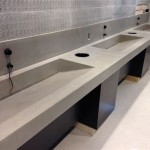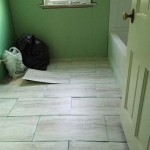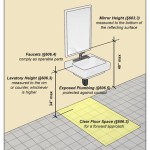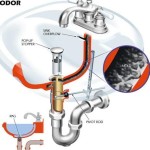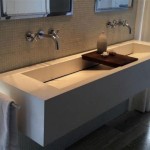Bathroom Sink Exposed Pipes: Aesthetics, Functionality, and Maintenance
Exposed pipes beneath a bathroom sink, once considered strictly utilitarian and hidden from view, are now a design element embraced by homeowners and interior designers alike. This design choice, often referred to as "exposed plumbing," moves beyond simply concealing functional elements, instead celebrating the raw, industrial aesthetic or complementing a minimalist or vintage style. However, beyond aesthetics, exposed pipes present practical considerations regarding functionality, maintenance, and potential challenges that must be addressed.
The shift towards embracing exposed pipes reflects a broader design trend that values authenticity and functionality. Rather than masking essential elements, this approach highlights them, often incorporating materials like copper, brass, or matte black steel for visual impact. The choice allows for greater accessibility for repairs and modifications, and can contribute to a more visually open and less cluttered bathroom space. This article will delve into the key aspects of incorporating exposed pipes into a bathroom sink design, exploring the stylistic considerations, the functional benefits and drawbacks, and the necessary maintenance protocols to ensure longevity and optimal performance of the plumbing system.
Aesthetic Considerations for Exposed Bathroom Sink Pipes
The visual impact of exposed pipes is substantial, and careful consideration must be given to their design and finish to achieve the desired aesthetic. The choice of material is paramount. Copper pipes, for example, offer a warm, reddish-brown tone that can develop a patina over time, adding character and visual interest. Brass pipes provide a similar warmth but with a more golden hue, often lending a touch of elegance and vintage charm. Stainless steel or black iron pipes, on the other hand, offer a modern, industrial look that complements minimalist or contemporary designs.
Beyond the material itself, the finish plays a crucial role. Polished finishes create a sleek, reflective surface, while brushed or matte finishes offer a more subdued and understated look. Powder coating, particularly in matte black or white, provides a durable and contemporary finish that can be easily maintained. The choice of finish should complement the overall bathroom décor, including the sink, faucet, and other hardware. Consistency in finish across all exposed elements creates a cohesive and visually appealing design.
The arrangement of the pipes is another critical aspect of the aesthetic. Simple, clean lines are generally preferred, avoiding unnecessary bends or loops that can appear cluttered. The pipes should be securely fastened to the wall or floor using appropriate brackets or supports, ensuring both stability and a polished appearance. Concealing the drain and supply lines within the wall as much as possible, while leaving the essential connections exposed, can create a cleaner and more streamlined look. Consideration should be given to the symmetry and balance of the pipe arrangement in relation to the sink and surrounding fixtures.
Furthermore, the exposed pipes can be integrated with other design elements to enhance the overall aesthetic. For example, incorporating open shelving beneath the sink can complement the exposed pipes and provide additional storage space. The shelving material and style should coordinate with the pipes and other bathroom fixtures to create a unified design. The pipes themselves can be adorned with decorative elements, such as vintage valves or industrial-style fittings, to add character and personalize the space. Thoughtful integration of lighting can also highlight the exposed pipes and create visual interest.
Functional Advantages and Disadvantages of Exposed Plumbing
Beyond aesthetics, exposed plumbing offers several functional advantages. One of the primary benefits is increased accessibility for repairs and maintenance. With the pipes readily visible, it is easier to identify leaks, clogs, or other plumbing issues. This allows for quicker diagnosis and repair, minimizing potential water damage and saving on plumbing costs. The absence of enclosed cabinetry also simplifies access for routine maintenance tasks, such as tightening connections or cleaning pipes.
Exposed plumbing also simplifies modifications or upgrades to the plumbing system. Adding a new fixture or rerouting pipes can be done more easily without having to dismantle cabinetry or drywall. This flexibility can be particularly beneficial in older homes where plumbing systems may require frequent updates or repairs. The exposed nature of the pipes also allows for easier visual inspection, enabling homeowners to monitor the condition of the plumbing system and identify potential problems before they escalate.
However, exposed plumbing also presents some functional challenges. One concern is the potential for damage to the pipes. Exposed pipes are more vulnerable to impact and abrasion, which can lead to leaks or other damage. This is particularly relevant in high-traffic areas or households with children or pets. Protecting the pipes with guards or barriers may be necessary to prevent accidental damage.
Another consideration is temperature regulation. Exposed pipes can be susceptible to temperature fluctuations, particularly in colder climates. This can lead to condensation on the pipes, which can drip and cause water damage. Insulating the pipes can help to mitigate this issue and prevent condensation. Additionally, exposed pipes can conduct heat, potentially leading to uncomfortable surface temperatures. This is less of a concern with cold water pipes but can be problematic with hot water pipes. Insulating the pipes or using a non-conductive material can help to reduce heat transfer.
Finally, exposed plumbing can be more difficult to clean than concealed plumbing. Dust, dirt, and grime can accumulate on the pipes, requiring regular cleaning to maintain a clean and sanitary environment. The intricate arrangement of some exposed pipe systems can make cleaning more challenging, requiring specialized tools or techniques. Regular cleaning is essential to prevent the buildup of grime and maintain the aesthetic appeal of the exposed pipes.
Maintenance and Care of Exposed Bathroom Sink Pipes
Proper maintenance is crucial to ensure the longevity and optimal performance of exposed bathroom sink pipes. Regular cleaning is essential to remove dust, dirt, and grime that can accumulate on the pipes. The frequency of cleaning will depend on the environment and usage of the bathroom, but generally, weekly or bi-weekly cleaning is recommended. A soft cloth and mild detergent are typically sufficient for cleaning most pipe materials. Avoid using abrasive cleaners or scouring pads, as these can scratch or damage the finish. For stubborn stains or tarnish, specialized cleaning products designed for the specific pipe material may be required.
Regular inspection of the pipes is also essential to identify potential problems early on. Check for leaks, corrosion, or other signs of damage. Pay particular attention to joints and connections, as these are often the most vulnerable points. If any leaks are detected, they should be repaired immediately to prevent water damage. Corrosion can be treated with specialized rust removers or sealants, depending on the severity of the corrosion. If the damage is extensive, replacement of the affected pipe section may be necessary.
Protecting the pipes from physical damage is also important. Consider installing guards or barriers around the pipes in high-traffic areas to prevent accidental impact. Avoid placing heavy objects on or leaning against the pipes, as this can cause stress and potential damage. If the pipes are exposed to extreme temperatures, insulating them can help to prevent condensation and heat loss. Proper insulation can also help to protect the pipes from freezing in colder climates, preventing burst pipes and costly repairs.
Furthermore, it's advisable to periodically check the pipe supports and brackets to ensure they are securely fastened. Loose or damaged supports can cause the pipes to sag or vibrate, which can lead to stress and potential leaks. Tighten any loose screws or replace damaged supports as needed. Maintaining the proper alignment and stability of the pipes is crucial for their long-term performance and aesthetic appeal. Regular maintenance and care will help to ensure that the exposed bathroom sink pipes remain functional, aesthetically pleasing, and free from problems for years to come.
Selecting quality materials and employing skilled plumbing professionals for the initial installation are also key factors in ensuring the longevity and minimizing the need for extensive maintenance. While the exposed nature of the pipes simplifies future repairs, a well-executed installation reduces the likelihood of these repairs in the first place.

Unexpected Beauty Exposed Plumbing Inview

Sink Pipes Worth Seeing

Pin On Tips Tricks

Unexpected Beauty Exposed Plumbing Inview

Creative Ways To Utilise The Under Sink Areas In Your Bathroom And Kitchen Hipcouch Complete Interiors Furniture

36 Best Exposed Plumbing Bathroom Ideas House Design

Bathroom Details Show Off Your Sink Line

8 Bathroom Vanity Style Ideas Sweeten Com

Pin On Bathroom

Exposed Copper Plumbing Design
